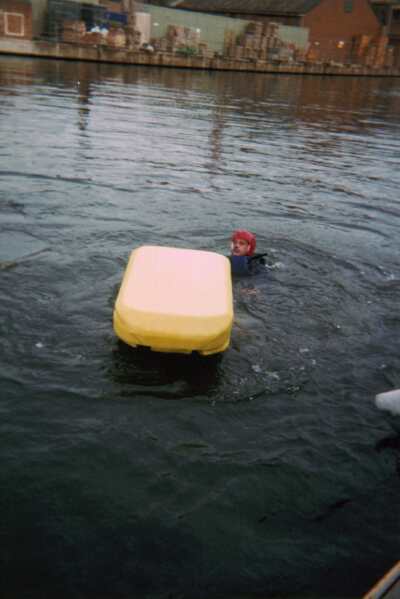 Super Spuds R Us!
Super Spuds R Us! 
 Super Spuds R Us!
Super Spuds R Us! 
 |
|
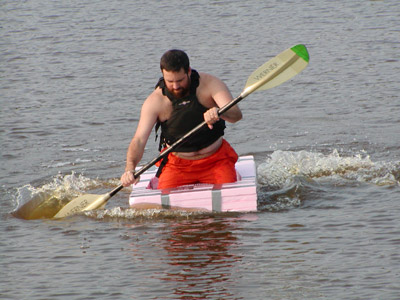 |
New! The Full Evolution:
This page is devoted to the design, construction and paddling of Super Spuds -- ultra-short homemade whitewater craft. They are paddled in the kneeling or C1 position and with a single-bladed paddle, although if you learn the correct roll, a kayak paddle can also be used.
Whitewater boat design has generally been getting shorter, from about 14 feet long in the 1980s to 9 foot as standard in the early 90s and then 7 foot boats becoming the norm in the late 90s. By 2002 there were several boats available that were in the 5'11" to 6'6" range.
I wanted to go one further, so taking it to the logical conclusion, I built a 4 foot boat. The implication of this is that you have to kneel as there is no room for your legs to stretch out. However, some of us like it that way! ;)
SuperSpuds are basically high tech coracles.
They are very light, no fuss or airbags or drainplugs required, you can keep one in your cupboard and carry it in the back seat of your car. It takes 2 seconds to hop in and be ready to launch -- no struggling with spray decks or backbands.
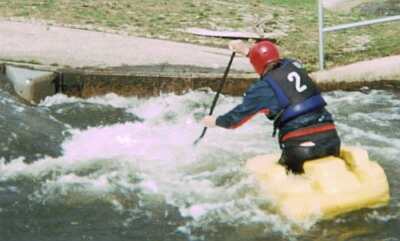
Access the smallest of features |
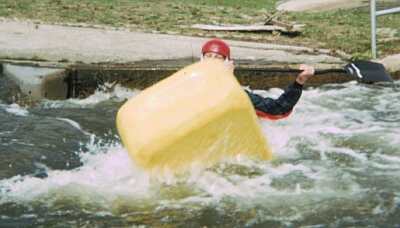
With no fear of hitting the bottom! |

Puts a smile on everyone's face... |

Everyone and his dog wants to try ... |
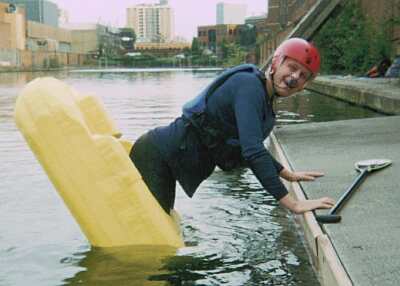
Bowstalls are easy |
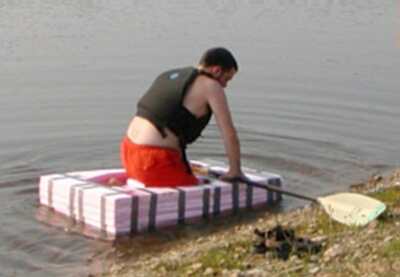
Jody in America has built his own prototype already, after the website has been up for just 4 days! |
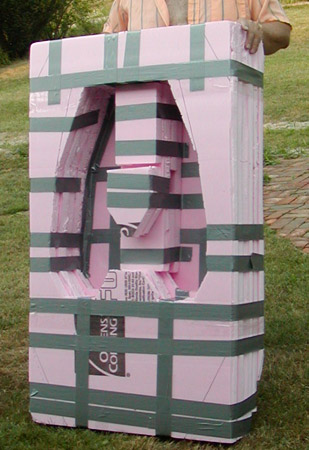
Duct tape as nothing will glue polystyrene ... |



The main problem is in making short and stubby curves look elegant , so I sought inspiration from other types of product, including the Jaguar XK180 which has some nice back end rocker, the Nokia 3210 mobile phone, which once squashed and stretched a bit, has a lovely form factor and a nice top deck curve. And the head shape of the Snowshoe Hare somehow helped inspire the bow rocker ...
The boat is a self-baling kneel-on-top. The hull is basically a flat planing surface, with friendly rounded corners. There is enough rocker for front and back ferrying/surfing, and the rounded front and back decks have pretty good resurfacing tendencies should pearling occur. The front has a bit more volume than the back for river running and to allow a forward lean when taking a stroke. C1 playboaters will know what I am on about here ;)
I was also looking for something that was nice and stable on end, which I partially achieved as it is lovely on the bow. Despite the thick cross section of the bow and stern, their short length means squirting and cartwheels are acessible too. I am not sure how it will endo / loop as the deck is very short which means it may not get much height, but then exactly because it is short it doesn't need much height to loop ...
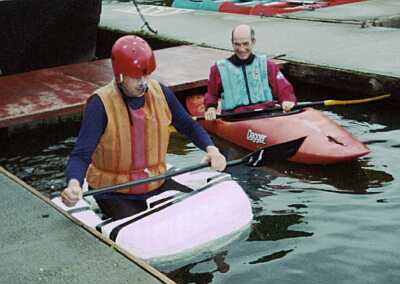

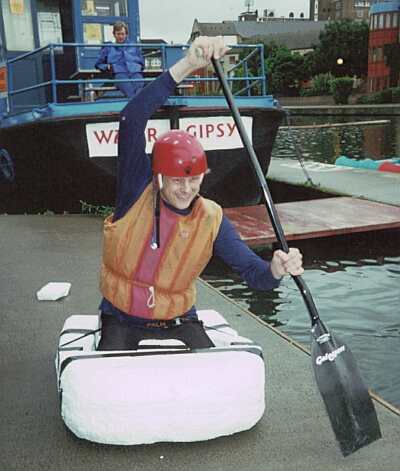


Note the swallowtail and zero stern rocker. In the end I chickened out of that as I thought it would catch while back surfing, so I rounded the stern instead. However, the swallowtail might have given a tad more speed, especially if you edge the boat while forward paddling ...
The boat is incredibly stable and very confidence-boosting.
If you want to play, then you need a good C1 roll -- starting on the back deck, then sweeping forward and coming up on a low brace. Get your nose on the front deck when you finish the roll, and grip yourself in tightly, and it should be fine. If you bow stall when you come up, just claim it was an intentional Zero to Hero move!
IMPORTANT SAFETY NOTE: You don't have to use straps -- straps carry significant risk and should be used only if you are an experienced C1er. It is very possible to cut the knee and thigh channels to be sufficently snug for you to be able to roll and cartwheel with no strap and yet still stay in the boat ...
Update -- I have not been using straps at all -- and while my roll is only about 50% after 1 hour's practice, it is improving fast, which suggests it really is a technique thing -- grip up with your knees and toes to stop yourself falling out. No straps make the boat very simple and so easy to hop in and out of, and very accessible for beginners. In the shallow (waist deep) British rivers and artificial courses I paddle in, you can just hop in midstream after a swim. It may be possible to climb on in deep water, kicking your feet like mounting a surfboard, but I haven't managed it yet. Obviously, a roll is preferable every time, but the easy entry (and exit!) and the fact that you don't need to empty the boat means that swimming is much less of a big deal.
 Deepwater self rescue is possible ...
Deepwater self rescue is possible ...

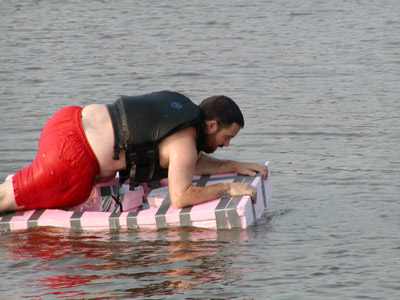
As you would expect, it's a little slow. But because displacement hull speed is related to the square root of waterline length, then this boat at 4 foot is only 20% slower than a 7 foot boat like a Topo or BigEZ. (Try it: max hullspeed in knots = sqrt(waterlinelength in feet)) Then of course, there's speed on a wave, and with the huge planing area, it actually goes nicely! The planing area is about 900 sq. in. (compare that with 640 sq in. on a Liquid Logic Session Plus (the only other people who publish stats on planing area...)
It surfs small waves as well as my Delirious and an S8 C1 paddler thought it was comparable too -- exceptionally stable but slicing and flatspins are obviously not nearly as smooth.
My only disappointment with this version of the boat is that Ferry Gliding is hard hard work -- I had hoped to get a planing situation on ferrying, but it remains stubbornly in displacement mode and so needs plenty of work to attain.
For more power I found myself doing strokes that are not so much cross bow as 'pre bow', starting about 2 feet in front of the bow and then drawing towards your belly, with a slice out to the offside to finish. A feature that is probably unique to this boat.
 The 'pre-bow' stroke
The 'pre-bow' stroke
I had considered cutting down the bow volume, but I am glad I didn't -- C1 paddling has a large vocabulary of moves that involve leaning on the front deck: bracing, rolling, bow stalls, resurfacing from drops, etc. You can lean forward with impunity and indeed pleasure!
One person who tried the boat suggested adding more volume to the stern as well -- I will consider this, but the real problem that needs solving is stability when in the stern station, which I am not sure is just to do with volume, as other short boat paddlers (eg GForce) mention that the short stern makes stern stalls tricky.
Not everyone is used to using a canoe paddle, but don't be put off because a kayak paddle is completely workable with a SuperSpud. Just two points -- please don't use high braces as it will wrench your shoulder. Likewise, trying your old sweep roll, starting with your nose on the front deck, will result in a failed roll and probably hyperextension of the shoulder. You have been warned! Practice in the pool first! If you are using a kayak paddle, then use a back deck or steyr roll [link ChrisJ]

It takes a weekend or two. I am a pretty clueless craftsman, so it can't be too hard! Spend more time thinking, planning and measuring than you do cutting, and it should end up right. For tools, I found a hacksaw to be ideal, with just the blade with a duct tape handle for long or tricky cuts -- the blade flexes to allow cutting out curves and knee bumps and so on. You cut out the basic outline, and then kneel in position and draw around your legs to get each layer. Pay attention to the trim position as that can be hard to change afterwards. Your centre of gravity is level with the front of the seat (ie directly below your belly button) and not midway between knee and toe as you might expect).
I cut down into my first layer so that the hull was 2 inches thick at the thinnest point. This raises your centre of gravity a bit, but is unavoidable I think. I ended up with an 8" high seat, which is super comfy -- I have NO foot or knee or ankle pain -- woo hoo! This shows the stability of the hull as every inch make a noticeable difference in stability in C1s ...



It would be possible to make a boat that is 3 foot long, but I think that is going a bit far -- it would be quite a challenge staying upright fore and aft ... However, you should note that I am 6'8" and 240 lbs, so you will probably want to reduce the dimensions somewhat -- you can get lower volume by having it less high -- my superspud is 14" high, you might manage with 11" or 12". I wouldn't go any narrower than 27" as you really really do need the stability that width brings. The key limits are: hull thickness at the knees and feet (1.5" would be the absolute limit I'd say -- this also determines the bow rocker angle), width (27" min) and length (distance from your knee to outstretched toe plus at least 12 inches)
Volume is good! For access to aerial moves and for surfing on micro features, then the more volume the better -- don't be shy of 60 gallons or so ... I have 7 inches of draft (depth below the waterline) but I would recommend going for much less than that -- 4 or even 3 -- this will give excellent stability and surfability. Here is a worked example to get a 4 inch draft for a 150 lbs person: A 4 foot by 28 inch by 4 inch thick slab is about (12.2 decimetres * 7.1 dm * 1.0 dm) = 87 litres. With the corners rounded off this is about 0.9*87 = 78 litres, which is enough to float 78 kg, which minus the weight of boat and gear is about 68 kg or 150 lbs. Add layers for a total boat height of 11 inches and you would be there.
For abrasion resistance and rock protection, I am planning to add a sheet of hypalon (raft fabric) or maybe cordura (rucksack fabric) to the bottom.
The materials cost was not bad when you consider that a new kayak is £700, and this is more fun! I paid £250 / $375 for the Plastazote foam, glue, and hypalon. Ethafoam is cheaper and adequate strength but not as fine-celled and only comes in black.
First I drew the 'FlooperSpud'...:
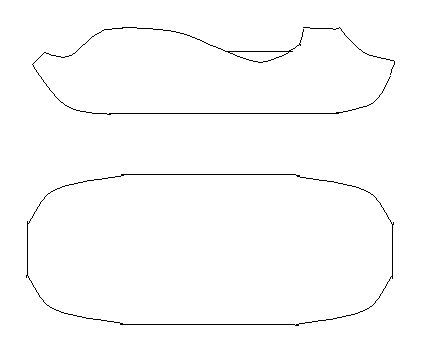
... which I made by chopping down the original SuperSpud:
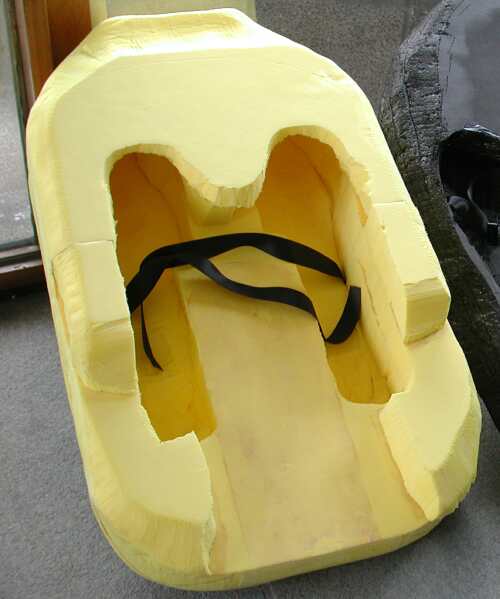 The FlooperSpud
The FlooperSpud
and it was suddenly possible to do lovely blunt-like manoueveres on flat water. However there was no vertical stability and any kind of bow or stern stall or cartwheel attempt led to instant capsize. And then you roll up straight into a vertical bowstall, which leads to instant capsize ... and so on etc. Double Drat! There's obviously a reason the Wavesport Transformers are easier with extra bits on the end ...
I went one further and chopped off a whole layer to make the SubSpud, which required straps, thinking I could actually loop up instead of rolling up. This did not quite work ... but came close, so maybe cutting even more volume would work? This would be a real pain to keep upright though, looking down at your watch would send you into a bow stall !... ;)
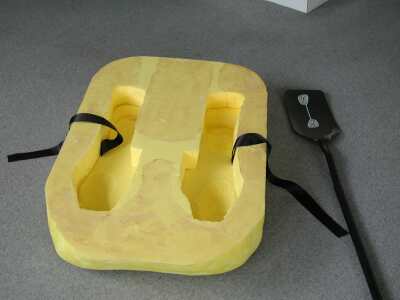 The SubSpud
The SubSpud
I now think that the original superspud is an end in itself, a sort of mini-canoe or OC1 (it would meet OC1 rules if you added a tiny airbag somewhere ...). So I will build it back up to it's pram like original bulbous front end.
What I needed next was something a bit longer, a bit thinner, more like a squirt boat, so enter the ...
